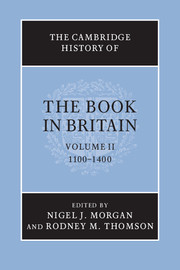Book contents
- Frontmatter
- Preface
- The roles of books
- Book production
- 3 The format of books – books, booklets and rolls
- 4 Layout and presentation of the text
- 5 Technology of production of the manuscript book
- 6 Handwriting in English books
- 7 Monastic and cathedral book production
- 8 Urban production of manuscript books and the role of the university towns
- Readership, libraries, texts and contexts
- List of abbreviations
- Bibliography
- Photo credits
- General index
- Index of manuscripts
- Plates 1
- Plates 2
- References
6 - Handwriting in English books
from Book production
Published online by Cambridge University Press: 28 November 2008
- Frontmatter
- Preface
- The roles of books
- Book production
- 3 The format of books – books, booklets and rolls
- 4 Layout and presentation of the text
- 5 Technology of production of the manuscript book
- 6 Handwriting in English books
- 7 Monastic and cathedral book production
- 8 Urban production of manuscript books and the role of the university towns
- Readership, libraries, texts and contexts
- List of abbreviations
- Bibliography
- Photo credits
- General index
- Index of manuscripts
- Plates 1
- Plates 2
- References
Summary
Twelfth-century scribes inherited a script which had been developed by scribes on the Continent during the ninth and tenth centuries, and imported into England in the mid-tenth century. This script, known as ‘Caroline Minuscule’, eventually became the basis for modern type faces. Scribes on the Continent had gradually eliminated variant letter shapes inherited from Antiquity, so that by the tenth century each letter had its own constant shape. Scribes constructed these shapes with a minimum of distinctive characteristics which appear at the level corresponding to the upper segment of the letter x. These characteristics, the ‘cues for legibility’, became the essential elements which enabled readers to identify letter shapes quickly.
The cues for legibility can be observed on this page by covering the tops of the ascenders of b, h, k and l and the bottom of all letters below the upper segment of x. At this level the reader distinguishes between different letter shapes formed with the same repetitive stroke: bp, dq, ceo and hkl. The arches of m and n, which distinguish them from i and u (for example, in the word ‘minimum’), and the essential elements which identify a, g, r, t and x itself, are all located at the same level. These cues for legibility have been invariable in all traditions of handwriting in the Latin West since the ninth century, but the shapes of letters – especially above and below minim-height – could be changed.
- Type
- Chapter
- Information
- The Cambridge History of the Book in Britain , pp. 110 - 135Publisher: Cambridge University PressPrint publication year: 2008
References
- 5
- Cited by



